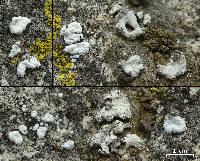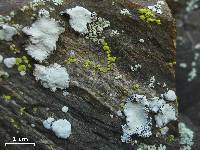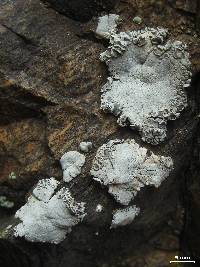
Consortium of Lichen Herbaria
- building a Global Consortium of Bryophytes and Lichens as keystones of cryptobiotic communities -
- Home
- Search
- Images
- Species Checklists
- US States: O-Z >
- US National Parks
- Central America
- South America
- US National Parks
- Southern Subpolar Region
|
|
|
|
Family: Lecanoraceae
[Lecanora marginalis Hasse] |
Nash, T.H., Ryan, B.D., Gries, C., Bungartz, F., (eds.) 2002. Lichen Flora of the Greater Sonoran Desert Region. Vol 1. Thallus: monophyllous, 0.7-1.5 cm across, entire or obscurely small-lobed, 0.5 mm thick (or slightly more towards circumference), edges: often rolled downward and convolutely folded upper surface: smooth to wrinkled and warty, continuous to unevenly rimose, grayish yellow but uniformly and finely white-pruinose, appearing white or grayish white lower surface: matt, light to moderate or dark yellowish brown or grayish brown (sometimes becoming blackish blue towards edge), sometimes strongly roughened and uneven; umbilicus: distinct Apothecia: 0.7-1.6 mm diam., adnate to sessile, marginal or submarginal, often crowded and often irregular from pressure, occasionally turned toward the substrate through the downward-rolling of the thallus margin; disc: concave to plane or undulate, brownish black, usually densely grayish pruinose and appearing light bluish gray; thalline exciple: 0.2-0.3 mm wide, concolorous with thallus, raised or finally level with disc, becoming flexuous or crenate, persistent; hymenium: c. 50 (-60) µm high, ± hyaline; uppermost c. 10 µm partly dirty greenish (pale bluish gray in K), with surface layer of ± fine grayish granules; paraphyses tips: becoming dark-capitate ascospores: globose to ovoid-ellipsoid, 9-14 x 6.5-8.5 µm Pycnidia: generally numerous conidia: 32-40 µm long Spot tests: upper cortex: K+ weakly yellowish, C+ lemon yellow, KC+ yellowish, P-, UV-; medulla: K-, C-, KC-, P-, UV- Secondary products: upper cortex with pseudoplacodiolic acid; medulla without substances. Substrate and ecology: on non-calcareous rock (especially volcanic), on lower side of overhangs World distribution: endemic to California (primarily central parts) Sonoran distribution: California, barely reaching the northern edge of the greater Sonoran Region (San Bernardino County). Notes: It is separated from R. glaucophana, which also has a white, C+ yellow upper cortex, by containing only pseudoplacodiolic acid, and having at least partly marginal apothecia (characters that distinguish these two species from other members of the genus), by the usually larger thalli and apothecia and especially by the broad, straight and rounded spores. The description of Lecanora marginalis given by Hasse (1910 & 1913) contains several statements that are inaccurate or at least misleading: 1) that the thallus is C-; 2) that the upper cortical cells are brown; 3) that the hypothecium is of coarse cells and of the same hue with the the epithecium [i.e., dull brownish black]; and 4) that the paraphyses tips are scarcely thickened. |
Powered by Symbiota




























